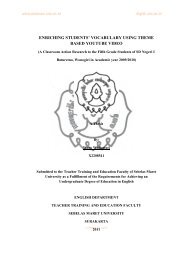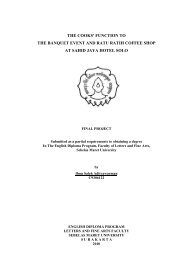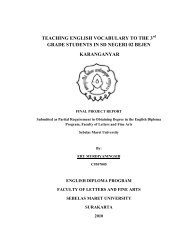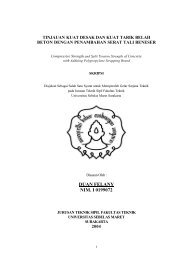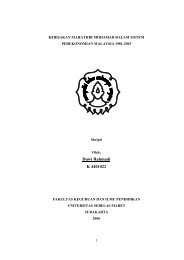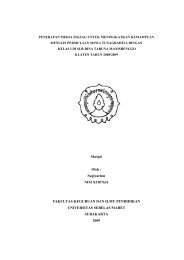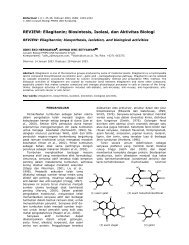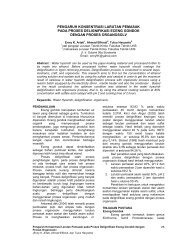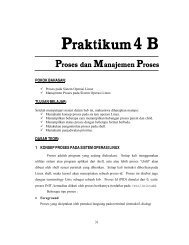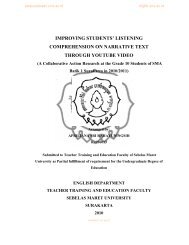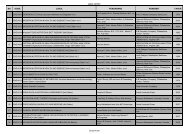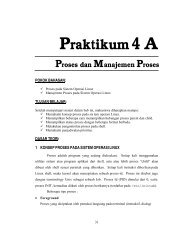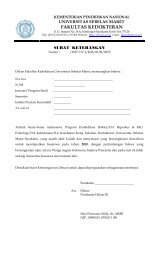Cluster Analysis of Ranunculus Species
Cluster Analysis of Ranunculus Species
Cluster Analysis of Ranunculus Species
Create successful ePaper yourself
Turn your PDF publications into a flip-book with our unique Google optimized e-Paper software.
B I O D I V E R S I T A S ISSN: 1412-033X<br />
Volume 3, Nomor 1 Januari 2002<br />
Halaman: 201-206<br />
<strong>Cluster</strong> <strong>Analysis</strong> <strong>of</strong> <strong>Ranunculus</strong> <strong>Species</strong><br />
S U R A N T O<br />
Biology Department, Faculty <strong>of</strong> Mathematics and Sciences, Sebelas Maret University Surakarta 57126.<br />
Received: 5 May 2001. Accepted: 31 July 2001<br />
ABSTRACT<br />
The aim <strong>of</strong> the experiment was to examine whether the morphological characters <strong>of</strong> eleven species <strong>of</strong> <strong>Ranunculus</strong><br />
collected from a number <strong>of</strong> populations were in agreement with the genetic data (isozyme). The method used in this<br />
study was polyacrilamide gel electrophoresis using peroxides, estarase, malate dehydrogenase, and acid<br />
phosphatase enzymes. The results showed that cluster analysis based on isozyme data have given a good support to<br />
classification <strong>of</strong> eleven species based on morphological groups. This study concluded that in certain species each<br />
morphological variation was pr<strong>of</strong>it to be genetically based.<br />
© 2002 Jurusan Biologi FMIPA UNS Surakarta<br />
Key Words: <strong>Ranunculus</strong>, isozyme<br />
INTRODUCTION<br />
<strong>Cluster</strong> <strong>Analysis</strong> has been widely used in<br />
studies <strong>of</strong> plant variation. Examples include<br />
Weis and Simmons (1979), Moran and Hooker<br />
(1983), Potts and Reid (1985b), Wittshire and<br />
Reid 1987, Menadue 1986. This method<br />
allows use <strong>of</strong> a number <strong>of</strong> phenetic variables<br />
in addition to cytological or genetic variables<br />
(Togan et. al., 1983).<br />
This analysis method using isozyme data<br />
has been shown to be quite valuable in<br />
providing better results to examine<br />
interrelationships between similar or different<br />
ploidy levels in plants. In the tetraploid plants<br />
Glycine tomentella, cluster analysis using<br />
isozyme data has been proved to be valid in<br />
grouping the species based on geographical<br />
origin <strong>of</strong> accessions (Doyle and Brown, 1985).<br />
A number <strong>of</strong> different methods <strong>of</strong> cluster<br />
analysis have been employed recently in plant<br />
taxonomic studies, particularly in studies <strong>of</strong><br />
lower level ranks <strong>of</strong> plant taxonomy, i.e.<br />
species or sub-species. Three <strong>of</strong> these are the<br />
weighted pair group method using averages<br />
(WPGMA), the unweighted pair group method<br />
using the centroid (UPGMC), and the<br />
unweighted pair group method using averages<br />
(UPGMA).<br />
These different sorts <strong>of</strong> cluster analysis<br />
provide techniques to distinguish or define<br />
samples (plants) based on the dissimilarities<br />
between the groupings in the field (Sneath and<br />
Sokal, 1973).<br />
Results <strong>of</strong> cluster analysis are mainly<br />
presented in the form <strong>of</strong> a dendrogram, which<br />
gives a clear position <strong>of</strong> each population<br />
sample indicated by the dissimilarity measure,<br />
for instance; the Euclidean Distance (D) or<br />
Squared Euclidean Distance (D 2 ) or<br />
Mahalanobis Distance.<br />
MATERIALS AND METHODS<br />
Plant materials<br />
Plants from seven populations around the<br />
Central Plateau, Tasmania were examined<br />
electrophoretically. The collected plants were<br />
identified with manuals <strong>of</strong> Bentham and<br />
Hooker (1865), Candole (1818-1821), Curtis<br />
(1956; 1967), Curtis and Morris (1975),<br />
Hooker (1982), and Menadue and Crowden<br />
(1989). Electro-phoresis procedures used<br />
were further explained in the next pages.<br />
Table 1 gives the location sites and the<br />
number <strong>of</strong> plants used in this study.
202<br />
BIODIVERSITAS Vol. 3, No. 1, Januari 2002, hal. 201-206<br />
Table 1. <strong>Ranunculus</strong> species and population sources<br />
used for electrophoresis.<br />
Population <strong>Species</strong> Plant<br />
number<br />
Liawenee R. triplodontus 16<br />
Nive River R. triplodontus 20<br />
Rats Castle R. triplodontus 15<br />
Clarence Weir R. triplodontus 20<br />
Ouse River R. triplodontus 13<br />
Projection Bluff R. triplodontus 10<br />
Wild Dog Plains R. triplodontus 12<br />
Wild Dog Plains R. jugosus 12<br />
Black Mary Plains R. pimpinellifolius 9<br />
Pine lake R. gunnianus 6<br />
Lake Agusta R. gunnianus 5<br />
Projection Bluff R. decurvus 10<br />
Rats Castle R. decurvus 10<br />
Projection Bluff R. collinus 10<br />
Rats Castle R. collinus 10<br />
Wild Dog Plains R. collinus 10<br />
Hasselwood Lagoon R. glabrifolius 12<br />
Lake Crescent Road R. glabrifolius 12<br />
Liawenee R. pascuinus 10<br />
Wild Dog Plains R. amphitricus 10<br />
Green View R. lappaceus 9<br />
Wild Dog Plains R. nanus 20<br />
Cameron Lagoon R. nanus 20<br />
Saint Patrick Plains R. nanus 20<br />
Ouse River R. nanus 20<br />
Clarence Weir R. nanus 20<br />
Gel preparation<br />
In order to make the best quality <strong>of</strong><br />
polyacrylamide gel, both two kind <strong>of</strong> stock<br />
solutions were prepared. Stock solution A was<br />
made by diluting 4,5 grams <strong>of</strong> TRI<br />
(Hydroximethyl) Methylamine (PURISS) and<br />
0,51 grams <strong>of</strong> citric acid into 500 ml deionized<br />
water, while the Stock solution B was prepared<br />
by mixing the 30 grams <strong>of</strong> Acrylamide and<br />
0.80 grams <strong>of</strong> NN-Methylene-Bis-Acrylamide<br />
into 100 ml <strong>of</strong> deionized water.<br />
Casting the gel<br />
Mixing 20 ml <strong>of</strong> solution B and 40 ml <strong>of</strong><br />
solution A made the gel. This mixture was<br />
deaerated on a Buchi rotary evaporator for 5<br />
minutes after which 0,04 ml <strong>of</strong> N,N,N',N'-<br />
Tetramethyl-ethylenediamine was added and<br />
with carefully mixed. To polymerize the gel,<br />
0,06 grams <strong>of</strong> Ammonium persulphate was<br />
added and mixed carefully immediately before<br />
pouring the solution into gel mould (BIO-RAD<br />
Model 361). Using this model, at least 4 thin<br />
gels each with 10-14 slots can be cast<br />
simultaneously.<br />
Protein extracting solution<br />
Diluting 0,018 grams <strong>of</strong> cysteine made up<br />
the solution <strong>of</strong> protein extraction. 0,021 grams<br />
<strong>of</strong> ascorbic acid and 5 grams <strong>of</strong> sucrose into<br />
20 ml <strong>of</strong> borax buffer pH 8.4.<br />
Extraction and loading the samples<br />
Laminas and petioles were examined<br />
separately. Material from each plant was<br />
ground individually in a staining dish using<br />
0.15-0.35 ml <strong>of</strong> protein extracting solution for<br />
laminas and 0, 1-0.15 ml for petioles. Despite<br />
the voluminous literature on extraction<br />
methodology which suggests the need to use<br />
frozen plant material (liquid nitrogen), it was<br />
found unnecessary for the systems studied in<br />
this project to use other than an ice cool buffer<br />
and hold plant material and extracts in a ice<br />
bath. The extracts were transferred to a small<br />
glass vial, 2 mm diameter, 3 cm long, and<br />
centrifuged at 3500 rpm for 15 minutes. The<br />
supernatants were then applied in the gel<br />
slots. The amount <strong>of</strong> sample loaded in each<br />
slot was for peroxidase about 10-15 ul, while<br />
for the other enzymes about 15-24 ul.<br />
Electrophoresis<br />
The electrophoresis chamber used in this<br />
project was a mini vertical slab cell<br />
manufactured by BIO-RAD, USA. model 360.<br />
This model has advantages in allowing use <strong>of</strong><br />
very small amounts <strong>of</strong> samples, as well as<br />
allowing a short running time<br />
Electrophoresis was conducted at a<br />
constant current <strong>of</strong> 5 mA for peroxidase (PER)<br />
and 7 mA for esterase (EST), malate<br />
dehydrogenase (MDH), and acid phosphatase<br />
(ACP), at room temperature for about 60<br />
minutes including a pre-electrophoresis time <strong>of</strong><br />
approximately 10 minutes. Electrophoresis<br />
was stopped when the bromophenol blue<br />
marker dye had traveled about 56 mm from<br />
the slot toward the anode.<br />
Staining procedures:<br />
Four enzymes staining were used routinely.<br />
1. Peroxidase (PER) was prepared by<br />
diluting 0.0125 grams <strong>of</strong> O-dianisidine into<br />
25 ml <strong>of</strong> acetone. Then 50 ml <strong>of</strong> 0.2 M<br />
acetate buffer pH 4.5 was added and 2<br />
drops <strong>of</strong> H 2 O 2 lastly given.
SURANTO – <strong>Cluster</strong> <strong>Analysis</strong> <strong>of</strong> <strong>Ranunculus</strong> <strong>Species</strong> 203<br />
2. Esterase (EST) was prepared by<br />
dissolving 0.0125 grams <strong>of</strong> α-naphthyl<br />
acetate in 2.5 ml acetone. After that 50 ml<br />
<strong>of</strong> 0.2 M phosphate buffer pH 6.5 and<br />
0.0125 grams <strong>of</strong> Fast Blue BB Salt were<br />
added.<br />
3. Malate dehydrogenase (MDH) was made<br />
up by mixing 15 ml <strong>of</strong> 0.1 M Tris-HCI pH 8<br />
and 0.020 grams <strong>of</strong> MTT (2.5-Diphenyl<br />
tetrazolium Bromide) and 0.005 grams <strong>of</strong><br />
PMS (Phenazine-Methosulfate) into 125 ml<br />
<strong>of</strong> deionized water. Mixed them gently and<br />
then 10 ml <strong>of</strong> 0.2 M. Sodium Malate pH 7,5<br />
was lastly added. The gel was incubated<br />
for 30-40 minutes in the dark. A fresh<br />
solution containing 0.020 grams <strong>of</strong> NAD<br />
(Nicotinamide Adenine Dinucleotide) was<br />
used to transfer the gel.<br />
4. Acid phosphatase (ACP) was made by<br />
diluting 0.0125 grams <strong>of</strong> <strong>of</strong> α-naphthyl<br />
phosphate into 2.5 ml <strong>of</strong> acetone and then<br />
75 ml <strong>of</strong> 0.2 M acetate buffer pH 4.5. 0.025<br />
grams <strong>of</strong> Fast Beach K Salt and 0.025<br />
grams were gently mixed.<br />
All staining procedures in this experiment<br />
were conducted at room temperature. For<br />
peroxidase and esterase stains refer to Mills<br />
and Crowden (1968), for malate<br />
dehydrogenase stains refer to Brown et al<br />
(1978), and for acid phosphatase stains refer<br />
to Adam and Jolly (1980).<br />
<strong>Cluster</strong> analysis<br />
Data used in this cluster analysis were<br />
isozyme band numbers. The bands were<br />
treated as characters, by giving values <strong>of</strong> 1<br />
and 0 to indicate presence (i.e. detectable)<br />
and absence (i.e. not detectable) <strong>of</strong> bands,<br />
respectively.<br />
Figure 1. Average linkage <strong>of</strong> UPGMA clustering eleven species <strong>of</strong> <strong>Ranunculus</strong>. Squared Euclidean Distance to<br />
measure dissimilarity based on band frequency <strong>of</strong> PER, EST, MDH, and ACP. Annotations: 1. R. decurvus, 2. R.<br />
amphitricus, 3. R. triplodontus, 4. R. jugosus, 5 R. pimpinellifolius, 6. R. pascuinus, 7. R. collinus, 8. R. glabrifolius, 9.<br />
R. gunnianus, 10. R. lappaceus, 11. R. nanus.
204<br />
BIODIVERSITAS Vol. 3, No. 1, Januari 2002, hal. 201-206<br />
There were 31 enzymic characters, 7<br />
isozyme bands <strong>of</strong> peroxidase, 9 <strong>of</strong> esterase, 6<br />
<strong>of</strong> malate dehydrogenase and 9 <strong>of</strong> acid<br />
phosphatase.<br />
A total <strong>of</strong> 341 individual plants belonging to<br />
the 11 species from a number <strong>of</strong> populations<br />
around the Central Plateau, Tasmania (Table<br />
1.) were scored with respect <strong>of</strong> 31 enzymic<br />
characters, 7 isozyme bands <strong>of</strong> peroxidase, 9<br />
<strong>of</strong> esterase, 6 <strong>of</strong> malate dehydrogenase, and 9<br />
<strong>of</strong> acid phosphatase.<br />
The data were then computed using the<br />
SAS program. The clustering strategy was<br />
Average linkage <strong>Cluster</strong> <strong>Analysis</strong> using<br />
Squared Euclidean Distance (UPGMA).<br />
RESULTS AND DISCUSSION<br />
<strong>Cluster</strong>s are shown in the dendrogram<br />
(Figure 1). At the eight groups level in the<br />
dendrogram, an excellent correspondence<br />
with the currently accepted taxonomy <strong>of</strong> these<br />
11 species <strong>of</strong> <strong>Ranunculus</strong> was obtained. Only<br />
R. pimpinellifolius and R. pascuinus are not<br />
separated as was hoped. It has revealed as<br />
distinct species, R. decurvus, R. amphitrichus,<br />
R. gunnianus, R. nanus, and R. lappaceus,<br />
and showed the close relationships between<br />
species pairs, R. glabrifolius-R. collinus, and<br />
R. triplodontus-R. jugosus. However the<br />
dissimilarity measure at this level is small.<br />
Figure 2. Average linkage <strong>of</strong> UPGMA clustering population <strong>of</strong> <strong>Ranunculus</strong> species. Squared euclidean distance to<br />
measure the dissimilarity based on band frequency <strong>of</strong> PER, EST, MDH, and ACP. Codes in the brackets indicate the<br />
population site. Annotations:<br />
A. R. glabrifolius (HwL) B. R. glabrifolius (StR) C. R. collinus (PBf)<br />
D. R. collinus (WDP) E. R. collinus (RCs) F. R. triplodontus (NRv)<br />
G. R. triplodontus (ORv) H. R. triplodontus (Lwn) I. R. amphitricus (WDP)<br />
J. R. triplodontus (CWr) K. R. triplodontus (PBf) L. R. triplodontus (RCs)<br />
M. R. nanus (SPP) N. R. pimpinellifolius (BMP) O. R. nanus (CWr)<br />
P. R. triplodontus (WDP) Q. R. jugosus (WDP) R. R. nanus (ORv)<br />
S. R. nanus (CLg) T. R. lappaceus (GVs) U. R. pascuinus (Lwn)<br />
V. R. decurvus (PBf) W. R. decurvus (RCs) X. R. nanus (WDP)<br />
Y. R. gunnianus (LAg) Z. R. gunnianus (PLk)
SURANTO – <strong>Cluster</strong> <strong>Analysis</strong> <strong>of</strong> <strong>Ranunculus</strong> <strong>Species</strong> 205<br />
At the ten groups level, the species R.<br />
pimpinellifolius and R. pascuinus were<br />
resolved, as were R. glabrifolius and R.<br />
collinus. However, the closely related R.<br />
jugosus and R. triplodontus were still united.<br />
The results <strong>of</strong> this analysis give generally<br />
good support to the classification <strong>of</strong> these 11<br />
species based on morphological grounds. A<br />
second analysis was carried out in which all<br />
the different populations were included<br />
separately. The results were presented in<br />
Figures 2 and 3. Figure 2. shows the grouping<br />
<strong>of</strong> species based on Euclidean Distance<br />
clustering strategy. At the 11 groups level, R.<br />
collinus and R. glabrifolius (2 populations <strong>of</strong><br />
each) from a neat cluster, but a 3rd population<br />
<strong>of</strong> R. collinus (Rats Castle) was quite remote<br />
from them. The second big branch <strong>of</strong> the tree<br />
consists <strong>of</strong> R. triplodontus mixed with R.<br />
pimpinellifolius, R. amphitrichus and R. nanus.<br />
The close relationship between R. triplodontus<br />
(Wild Dog Plains) and R. jugosus (Wild Dog<br />
Plains) was maintained. Both R. gunnianus (2<br />
populations) and R. decurvus (2 populations)<br />
were separately clustered, while R. pascuinus<br />
and R. lappaceus shared one group. Both R.<br />
nanus and R. triplodontus were scattered into<br />
several different groups. This indicates that in<br />
both these species, there is considerable<br />
"between-population" variation, which may<br />
swamp between-species variation.<br />
Figure 3. Average lingkage <strong>of</strong> UPGMA clustering population <strong>of</strong> <strong>Ranunculus</strong> species. Mahalanobian distance to<br />
measure the dissimilarity derived from non parametric multiple discriminant function analysis: based on band<br />
frequence <strong>of</strong> PER, EST, MDH, and ACP. Codes in the brackets indicate the population site.<br />
A. R. glabrifolius (HwL) B. R. glabrifolius (StR) C. R. collinus (PBf)<br />
D. R. collinus (WDP) E. R. collinus (RCs) F. R. triplodontus (NRv)<br />
G. R. triplodontus (ORv) H. R. triplodontus (Lwn) I. R. amphitricus (WDP)<br />
J. R. triplodontus (CWr) K. R. triplodontus (PBf) L. R. triplodontus (RCs)<br />
M. R. nanus (SPP) N. R. pimpinellifolius (BMP) O. R. nanus (CWr)<br />
P. R. triplodontus (WDP) Q. R. jugosus (WDP) R. R. nanus (ORv)<br />
S. R. nanus (CLg) T. R. lappaceus (GVs) U. R. pascuinus (Lwn)<br />
V. R. decurvus (PBf) W. R. decurvus (RCs) X. R. nanus (WDP)<br />
Y. R. gunnianus (LAg) Z. R. gunnianus (PLk)
206<br />
BIODIVERSITAS Vol. 3, No. 1, Januari 2002, hal. 201-206<br />
Comparing the Euclidean strategy with the<br />
use <strong>of</strong> Mahalanobis Distances (Figure 3), it<br />
appears that the latter provides a neater<br />
grouping <strong>of</strong> the species populations. At the<br />
eight groups level the closely related R.<br />
collinus (3 populations) and R. glabrifolius (2<br />
populations) form one cluster. R. decurvus and<br />
R. gunnianus each form a cluster, while R.<br />
lappaceus and R. pascuinus share one<br />
cluster. The major cluster contained the other<br />
species, with R. nanus and R. triplodontus<br />
spread through the minor sub-groupings.<br />
CONCLUSION<br />
On the basis <strong>of</strong> these data, there is no<br />
evidence to support Menadue's notion that R.<br />
collinus and R. glabrifolius might be united into<br />
a single species. Their close relationship is<br />
shown in that they cluster closely in the<br />
dendrogram, but always in discrete subgroupings.<br />
However, there is sample support<br />
for the hypothesis that some populations <strong>of</strong> R.<br />
nanus (Menadue and Crowden, 1990) and<br />
probably R. triplodontus also, are genetically<br />
different. This is explored further in the<br />
following sections.<br />
REFERENCES<br />
Adam and Jolly. 1980. Electrophoretic buffer system and<br />
stain recipes. In CSRIO, Division <strong>of</strong> Forest Research<br />
(Ed.). Sydney: CSIRO.<br />
Bentham, G and J.D. Hooker. 1865. Genera Plantarum.<br />
Volume I. London: Reive Br. Co.<br />
Brown, A.D.H., E. Nevo, D. Johary and O. Dagon. 1978.<br />
Genetic variation in natural populations <strong>of</strong> wild barley<br />
(Hordeum spontaneum ). Genetica 49 (2/3): 97-<br />
108.<br />
Candole, A.P. de. 1818-1821. Regni Vegetabilies<br />
Systema Naturale. Two Volumes. Paris: Treuttel et<br />
Wurtz.<br />
Curtis, W.M. 1956. A Student's Flora <strong>of</strong> Tasmania. Part I.<br />
Hobart: Government Printing.<br />
Curtis, W.M. 1967. Introduction in the Endemic Flora <strong>of</strong><br />
Tasmania. London: Airel Press.<br />
Curtis, W.M. and D.J. Morris. 1975. A Student’s Flora <strong>of</strong><br />
Tasmania I. 2 nd edition. Hobart: Government Printing.<br />
Doyle, M.J., J.E. Grant, and A.H.D. Brown. 1986.<br />
Reproductive isolation berween isozyme groups <strong>of</strong><br />
Glycine temontella (Leguminaosae) and<br />
spontaneus doubling in their hybrids. Australian<br />
Journal <strong>of</strong> Botany 34: 532-535.<br />
Hooker, J.D. 1982. The Flora <strong>of</strong> British India Volume I.<br />
Ranunculaceae to Sapindaceae. New Delhi: Bishen<br />
Sing Mahendra PA Sing Pub.<br />
Menadue, Y and R.K. Crowden. 1989. Tasmanian<br />
species <strong>of</strong> <strong>Ranunculus</strong>. A New Key Paper and<br />
Proceedings <strong>of</strong> the Royal Society <strong>of</strong> Tasmania.<br />
Volume 123: 87-96.<br />
Menadue, Y. 1986. Taxonomy <strong>of</strong> genus <strong>Ranunculus</strong> in<br />
Tasmania. PhD Thesis. Tasmania: New Castle<br />
University.<br />
Menadue, Y. and R.K. Crowden. 1990. Leaf<br />
polymorphism in <strong>Ranunculus</strong> nanus Hook.<br />
(Ranunculaceae). New Phytol. 114: 265-274.<br />
Mills, A.K. dan R.K. Crowden. 1968. Distribution <strong>of</strong><br />
soluble proteins and enzymes during early<br />
development <strong>of</strong> Pisum sativum. Australian Journal<br />
<strong>of</strong> Biological Science 21: 1131-1141.<br />
Moran, G.F. and S.D. Hooker. 1983. Genetic diversity<br />
and the insular population structure <strong>of</strong> the rare<br />
granite rock species, Eucaliptus casia Benth.<br />
Australian Journal <strong>of</strong> Botany 31: 161-172.<br />
Moran, G.F., J.C. Bell, and S. Prober. 1990. The utility <strong>of</strong><br />
isozyme in systematics <strong>of</strong> some Australian tree<br />
groups. Australian Systematic <strong>of</strong> Botany 3: 47-57.<br />
Post, D.M. 1983. Contribution to chromosome number<br />
atlas <strong>of</strong> the New Zealand Flora 26 – Gentiana<br />
(Gentianaceaea). New Zealand Journal <strong>of</strong> Botany 21:<br />
229.<br />
Sneath, P.H.A and R.R. Sokal. 1973. Numerical<br />
Taxonomy.San fransisco: W.H. Freeman and Co.<br />
Togan, L. N. Aydem, and A. Kence. 1983. A numerical<br />
taxonomic study Carthamus L. Taxa in Turkey.<br />
Felsenstain, J. (ed.). Berlin: Springer-Verlag.<br />
Weis, T.W. and D.M. Simmons. 1979. Variation in<br />
Australian and some overseas population Emex<br />
australis and Emex spinosa. Australian Journal <strong>of</strong><br />
Botani 27: 631-641.<br />
Wiltshire, R.J.E. and J.B. Reid. 1978. Genetic for<br />
variation in the spining gum, Eucalyptus perriana F.<br />
Muell. Ex. Rodway. Australian Journal <strong>of</strong> Botani 35:<br />
33-47.



